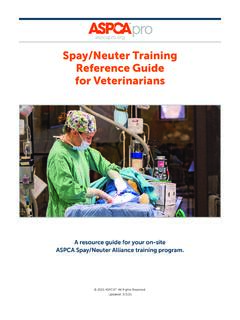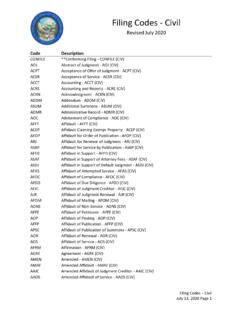Transcription of Toxicology Brief - ASPCApro
1 580 JULY 2004 Veterinary MedicineToxicology Briefmanaging common poisonings in companion animalsIbuprofen toxicosis in dogs, cats, and ferretsEric Dunayer, MS, VMDA nonsteroidal anti-inflammatory drug (NSAID) de-rived from propionic acid, ibuprofen has analgesic,anti-inflammatory, and antipyretic effects. It is com-monly used in humans for short-term management of painand fever and for long-term control of arthritic pain. It comesin various strengths. For over-the-counter use, it is availablein 50- and 100-mg capsules or tablets (often chewable) and20- and 40-mg/ml liquids for children, and in 200-mg tabletsand capsules for adults.
2 Prescription-strength tablets are 400,600, and 800 mg. Ibuprofen also can be found combinedwith other medications such as pseudoephedrine hydrochlo-ride or hydrocodone bitartrate. Common brand names ofibuprofen preparations include Advil (Wyeth), Midol (BayerHealthCare), and Motrin (McNeil Consumer), althoughibuprofen also is available in many generic humans, ibuprofen taken at standard dosages appearsto have a wide margin of safety. In general, there are fewerside effects than with similarly dosed , indogs, cats, and ferrets, ibuprofen has a narrow margin ofsafety and is a frequent toxicosis reported to the ASPCAAni-mal Poison Control Center (APCC).
3 In one review of ASPCAAPCC data on calls reporting generic drug exposures in dogsand cats, ibuprofen was the most common drug were the animals most commonly poisoned by ibupro-fen, and most exposures were acute usually the result ofingestion of numerous tablets after a dog chewed open abottle (ASPCA APCCD atabase: Unpublished data, 2001 2003).Some ibuprofen formulations have a sweet coating and arereadily eaten by dogs. In some cases, ibuprofen was admin-istered to pets in the mistaken belief that it was safer than as-pirin (ASPCA APCCD atabase: Unpublished data, 2001 2003).
4 While the exact mechanism of ibuprofen s action is notfully understood, it is generally thought that ibuprofen in-hibits the conversion of arachidonic acid into various pros-taglandins by reversibly blocking the actions of cyclooxyge-nase (COX) enzymes. By inhibiting COX-2 enzymes, ibupro-fen reduces the production of inflammatory mediators suchas prostaglandin E2(PGE2)and prostaglandin F2 (PGF2 ).3 However, ibuprofen also inhibits COX-1 enzymes, whichcan reduce the production of substances necessary formaintaining the normal gastric mucosal barriers, renalblood flow, and platelet 80% of ibuprofen is absorbed when taken orally inhumans1; in dogs, 60% to 86% of the dose is , the time to reach peak plasma concentrations variesfrom 47 to 120 minutes, depending on the formulation.
5 Liq-uid forms reach peak concentrations soonest, chewablesnext, and tablets last. Ingesting ibuprofen with food de-creases the peak plasma concentration and increases thetime to reach is highly protein-bound (90% to 99%).1 Elimina-tion is through hepatic biotransformation to inactive metabo-lites excreted by kidney filtration and secretion. About 70% ofthe drug is excreted in the urine as metabolites or unchangeddrug; the rest is lost through feces. Marked enterohepatic re-PharmacokineticsMechanism of action Toxicology Brief was contributed by Eric Dunayer, MS, VMD, ASPCAA nimal Poison Control Center, 1717 S.
6 Philo Road, Suite 36, Urbana, IL61802. The department editor is Petra A. Volmer, DVM, MS, DABVT, DABT,College of Veterinary Medicine, University of Illinois, Urbana, IL 2004 Veterinary Medicinecirculation dogs, the elimi-nation half-life is to Ibuprofen has a narrow margin ofsafety in dogs. One recommendeddosage is 5 mg /kg /day, , signs of toxicosis have been seenwith a dosage of 8 mg /kg /day for 30days. At this dosage, no clinical signswere seen, but the dogs developed gas-tric ulcers and intestinal 16 mg /kg /day, vomiting, diarrhea,melena, and weight loss were evidentby the eighth week of one case report, a dog given 3mg /kg every other day for six weeksdeveloped a fatal gastric insufficiency or failure, impairedhepatic function, hypoalbuminemia,stress (such as recent surgery)
7 , or con-current administration of glucocorti-coids may increase the toxicity ofibuprofen administered ,8An acute ibuprofen overdose indogs, cats, ferrets, and humans is as-sociated with gastrointestinal, renal,and central nervous system signs. Gas-trointestinal signs are thought to bedue to the inhibition of COX-1 en-zymes and the loss of normal gastricprotective mechanisms, though thismay be an oversimplified explanationof the , abdomi-nal pain, hematemesis, and diarrheacan be seen within 24 hours of , acute overdoses as lowas 25 mg/kg can cause vomiting indogs (ASPCA APCCD atabase: Unpub-lished data, 2003).
8 At doses greater than 175 mg/kg,the risk of acute renal failure in dogsincreases. In the kidney, prostaglan-dins are responsible for vasodilationand maintenance of the renalmedulla s blood flow, especially dur-ing hypovolemic states. Ibuprofenblocks these vasodilatory prostaglan-dins. The resultant diminished renalblood flow can lead to acute interstitialnephritis, papillary necrosis, renal-tubular necrosis, and acute renal fail-ure. Preexisting renal disease, hypo-volemia (possibly from vomiting andconcurrent dehydration), and hypoten-sion can increase the risk of renal toxi-city from doses greater than 400 mg/kg,central nervous system effects can beseen in dogs, including depression,seizures, and mechanismfor these signs is unknown.
9 The mini-mum lethal dose in dogs is about 600 addition, hepatotoxicity(especially with long-term use) and in-hibition of platelet function have beenreported in 1shows signs associated withincreasing doses of ibuprofen in BriefcontinuedTABLE 1 Ibuprofen Dose and Associated Signs or Outcomes in Dogs*DoseAssociated Signs or Outcomes 25 125 mg/kgVomiting, diarrhea, nausea, abdominal pain, anorexia>175 mg/kgAll of the above plus hematemesis, melena, polyuria or polydipsia, oliguria, uremia, acute renal failure >400 mg/kgAll of the above plus seizures, ataxia, coma, shock>600 mg/kgDeath*Source: Adapted from Villar, D.
10 Et al.: Ibuprofen, aspirin and acetaminophen toxicosis and treatment in dogs and cats. Vet. Hum. Toxicol. 40(3):156 161; 199; and the ASPCA APCC Database: Unpublished data, 2001 2003. 584 JULY 2004 Veterinary MedicineCats, because of limited glucuronyl-conjugating ability, are thought to betwice as sensitive as dogs to ibupro-fen s toxic are especially sensitive toibuprofen s toxic effects. Because oftheir small size (an adult weight of 2 kg),12ingestion of a single 200-mg tablet can result in a dose of 100to 400 mg/kg. In one review of casesreceived by the ASPCA APCC, 93% offerrets ingesting ibuprofen developedneurologic signs, including depres-sion, coma, and ataxia.










